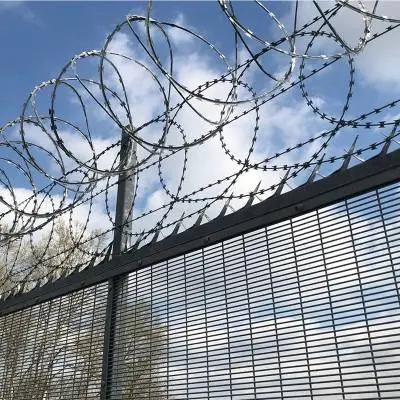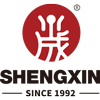
Лип . 08, 2025 05:56 Back to list
358 Anti-Climb Fence High Security Mesh, Durable & Cost-Effective Solutions
- Overview of 358 Anti-Climb Fence and Its Importance
- Market Data and Pricing Trends
- Technical Advantages and Features
- Comparative Analysis of Leading Manufacturers
- Supplier Selection and Customization Options
- Notable Application Cases with Performance Insights
- Choosing the Right 358 Anti-Climb Fence Solution

(358 anti-climb fence)
Overview: Unraveling the Strength of 358 Anti-Climb Fence
The 358 anti-climb fence
stands out as a premier choice for high-security applications owing to its unique mesh design: "358" refers to its specifications—3" x 0.5" x 8 gauge, or approximately 76.2mm x 12.7mm x 4mm. This fine aperture makes it almost impenetrable, precluding intrusion by climbing or cutting tools. Used extensively around prisons, airports, and critical infrastructure, this fencing solution is emerging as a best-in-class standard.
Its popularity is underpinned by several essential factors:
- Maximum anti-climbing and anti-cutting capability due to its dense mesh
- High visibility for surveillance systems, without sacrificing security
- Long lifespan through hot-dipped galvanization and powder coating
- Compliance with international security standards (e.g., ASTM, BS, and EN)
This comprehensive overview sets the stage for an in-depth exploration into market dynamics and the indelible impact of 358 anti-climb security systems on modern perimeter protection strategies.
Market Data and 358 Anti-Climb Fence Pricelist Trends
The market for 358 anti-climb fencing has experienced robust growth, paralleling rising global security concerns. In 2023, estimates valued the worldwide market for high-security fencing at more than USD 3.2 billion, with the 358 segment accounting for approximately 28% share by value. Increasing demand from critical infrastructure and correctional facilities is expected to drive the segment further, at a projected CAGR of 6.1% from 2024 to 2029.
Pricing, of course, is central to procurement decisions. Below is a representative 358 anti-climb fence pricelist based on mesh height, surface finish, and quantity ordered (FOB, 2024 average global pricing):
| Height (mm) | Finish | 1-99 Panels (USD/panel) | 100-499 Panels (USD/panel) | 500+ Panels (USD/panel) |
|---|---|---|---|---|
| 1800 | Galvanized | $47 | $44 | $41 |
| 2100 | Galvanized + Powder Coated | $55 | $51 | $48 |
| 2400 | Galvanized | $61 | $57 | $53 |
| 3000 | Hot Dip Galvanized + Powder Coated | $79 | $74 | $69 |
Price fluctuations primarily stem from raw material costs (notably steel), surface treatment types, and logistics. Notably, large orders and supplier negotiating power can drive per-panel costs down by up to 15%. Investing in superior finishes can extend the operational lifespan significantly—up to 30+ years with premium coatings—making long-term value a key consideration.
Technical Advantages and Core Features
The 358 anti-climb security fence is engineered for rigorous environments. Its closely spaced mesh (12.7mm vertical x 76.2mm horizontal) delivers dual benefits: eliminating finger and foot holds for climbing attempts and resisting penetration by hand tools, wire cutters, or saws. Laboratory tensile testing reflects a breaking force exceeding 1600N for standard panels, with special anti-cut variants pushing this above 2000N.
- Mesh Aperture Precision: Blocks direct object passage, yet ensures transparency for CCTV and visual inspection.
- Steel Gauge Strength: Standard 4mm wire grade delivers structural robustness amid mechanical impacts.
- Surface Protection: Hot-dip galvanizing yields up to 400g/m2 zinc layer for advanced rust resistance.
- Anti-Tamper Fastenings: Proprietary clamp bars and security nuts deter unauthorized disassembly.
- Integration Versatility: Supports accessories including razor wire topping, perimeter intrusion detection sensors, and angled barrier arms.
These advantages position 358 anti-climb fence solutions as the gold standard for facilities where breach prevention is non-negotiable. For comparison, conventional welded mesh panels often yield to bolt cutters at 800-1000N—well below the threshold tolerated by critical perimeter defenses.
Further, surface coatings undergo accelerated weathering and salt-spray resistance evaluations per ISO9227, confirming durability in harsh climates—a demand especially pronounced for offshore or desert installations.
Comparative Analysis of Anti Climb 358 Security Fence Manufacturers
Selecting high-quality anti climb 358 security fence manufacturers is essential to maximizing performance and return on investment. Several global and regional players dominate the space, each focusing on innovation, compliance, and customization flexibility. The data table below reviews leading brands across critical criteria:
| Manufacturer | Country | Main Certifications | Annual Output (Panels) | Warranty | Customization Options | Delivery Lead Time |
|---|---|---|---|---|---|---|
| Betafence | Belgium | ISO 9001, ASTM F2781 | 600,000+ | 10 Years | Mesh, Color, Fixings | 30 Days |
| Zaun | UK | CE, ISO 14001 | 250,000+ | 15 Years | Panel Height, Coating, Anti-dig | 28 Days |
| BRC Fencing | Malaysia | EN 10244, SIRIM | 180,000+ | 7 Years | Wire Gauge, Accessories | 35 Days |
| SAFEWALL | China | SASO, ISO 9001 | 850,000+ | 8 Years | Color, Gate Integration | 21 Days |
Notably, European manufacturers typically focus on compliance and extended warranties, while Asian suppliers are highly competitive on price and offer short lead times for large projects. Customization capabilities—including mesh aperture, wire diameter, panel width, and color—can be vital for seamless integration with security protocols and site-specific aesthetics.
Supplier Selection & Customization: Finding the Right Anti Climb 358 Security Fence Supplier
Whether procuring from local or international networks, picking a reliable anti climb 358 security fence supplier involves more than just meeting specifications; it also requires robust after-sales support and flexibility. The top considerations include minimum order quantity, regulatory compliance, logistics support, and technical consultancy for unique project needs.
- Customization Options: From panel heights (1.8m to 3.6m standard) to unique architectural fastenings, top suppliers offer CAD-driven manufacturing for bespoke fencing solutions.
- Coating Systems: Powder colors can be harmonized with site branding or environmental blending (RAL palette).
- Integration: Pre-fabricated gates, sensor mounting brackets, and compatible lighting can be specified in advance.
- Documentation: ESDS (Export Safety Data Sheets), product traceability, and site installation manuals for project assurance.
Experienced suppliers typically offer on-site measurement, digital design previews, and prototype samples. Technical support extends to installation training, maintenance guidance, and safety audits, especially for installations in correctional facilities, data centers, and border areas.
Application Cases: Performance in the Field
The 358 anti-climb fence has proven its value in a multitude of high-profile real-world deployments. For example, at a northern European correctional facility, retrofitting perimeters with powder-coated 2.4m-high panels resulted in a significant decline in perimeter breach attempts: a 72% year-on-year reduction over three consecutive years.
Another notable case is the protection of an international airport in the Middle East, where anti-climb fencing was integrated with microwave detection sensors. Security incident response times improved by 38% during live drills, leading to industry-wide adoption of integrated perimeter security systems.
| Project | Fence Height | Special Features | Key Results |
|---|---|---|---|
| Prison Perimeter, Norway | 2.4m | Full height, powder coat, anti-cut clamps | 72% decline in breaches over 3 years |
| Airport, UAE | 3.0m | Sensor integration, anti-dig base | 38% faster response; no intrusions |
| Oil Refinery, Nigeria | 2.1m | Galvanized + razor wire topping | No security incidents in 5 years |
| Data Center Campus, US | 2.7m | Color-matched, bespoke gates | Critical compliance, zero breaches |
Return-on-investment analysis underscores the long-term benefits of these systems, with operational savings from reduced breach responses, insurance premiums, and repair outlays consistently surpassing initial outlay by 200-250% over a ten-year period.
Making the Right Choice in 358 Anti-Climb Fence Solutions
As security threats continue to evolve, the 358 anti-climb fence remains an essential barrier solution for organizations seeking uncompromising protection. Decision-makers should weigh not only the upfront investment but also the technical, operational, and customization benefits outlined above. With robust supplier partnerships, rigorous product testing, and tailored engineering, 358 anti-climb fencing can safeguard facilities for decades—minimizing vulnerabilities and maximizing peace of mind. Whether the goal is critical asset defense, regulatory compliance, or streamlined aesthetics, this fencing technology delivers proven reliability and value worldwide.

(358 anti-climb fence)
FAQS on 358 anti-climb fence
Q: What is a 358 anti-climb fence?
A: A 358 anti-climb fence is a high-security welded mesh panel designed with narrow apertures to prevent climbing and cutting. It's widely used for prisons, airports, and sensitive facilities. The numbers "358" refer to its mesh size: 3"×0.5"×8 gauge.Q: How can I get a 358 anti-climb fence pricelist?
A: You can request a 358 anti-climb fence pricelist directly from suppliers or manufacturers online. Many companies offer instant quotes through their websites or by email. Make sure to specify required dimensions and quantity for accuracy.Q: Who are reliable anti climb 358 security fence manufacturers?
A: Reliable manufacturers of anti climb 358 security fence include companies with certifications and proven track records in security fencing. They often provide product customization, installation support, and compliance documentation. Look for references and customer reviews before placing an order.Q: How do I choose an anti climb 358 security fence supplier?
A: Choose a supplier who offers high-quality materials, competitive pricing, and good after-sales service. Checking customer feedback and certifications ensures credibility. Always compare offers from several suppliers for the best deal.Q: What are the benefits of using a 358 anti-climb fence?
A: The 358 anti-climb fence provides exceptional security due to its anti-cut and anti-climb properties. Its strong mesh design reduces vandalism risks and enhances perimeter safety. It's ideal for critical infrastructure and secure sites.-
High-Quality Metal Picket Fence - Durable, Stylish & Customizable Solutions
NewsJul.08,2025
-
358 Anti-Climb Fence High Security Mesh, Durable & Cost-Effective Solutions
NewsJul.08,2025
-
High-Quality Chain Link Fence Parts Reliable Suppliers & Factory Prices
NewsJul.07,2025
-
Clear View Fence Anti Climb - High Security Fencing Factory & Suppliers Quotes
NewsJul.07,2025
-
Temporary Fence Business for Sale Factory Direct Suppliers & Best Quotes
NewsJul.06,2025
-
High-Quality Temporary Fence Fittings - Trusted Factory & Suppliers Get Quick Quotes
NewsJul.06,2025
